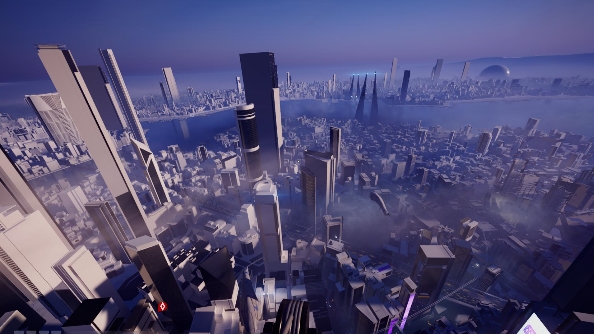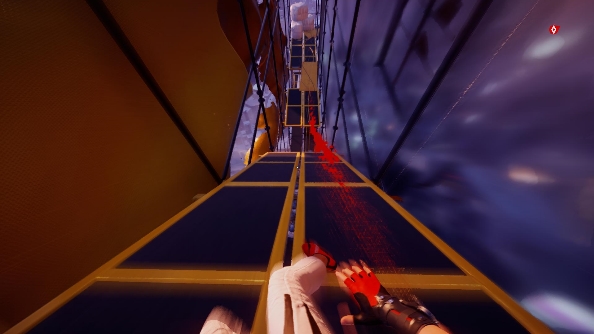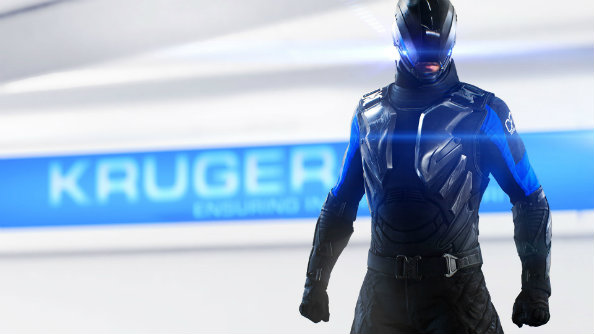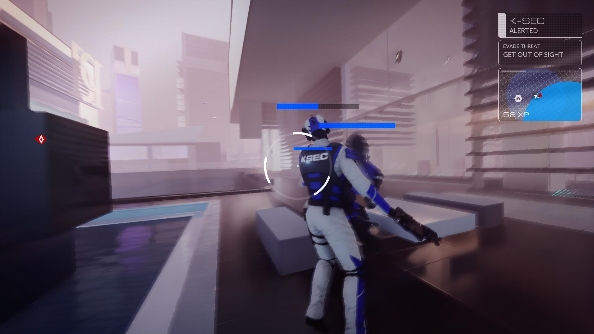The scene is practically silent, but becomes deafening in its intensity. There’s the squeak of sneakers against immaculate fibreglass. The crash of a maintenance door shouldered open. A grunt as Faith vaults over exposed piping, legs tucked in close. And eventually, just the rush of wind in her ears. You might be wincing and grasping for purchase on the mouse, sweating through a segment you’ve fluffed umpteen times before, but in the virtuoso display on-screen, speed is sustained. This and only this is what Mirror’s Edge is about: momentum. Nothing more, nothing less. It’s about time EA realised that.
Read more: check out the best PC games that 2016 has to offer so far.
The best thing Mirror’s Edge reboot Catalyst did was not muck up the running. And that’s higher praise than it sounds. A decade ago, a DICE team led by Owen O’Brien – now lead producer on Eve Valkyrie, another breathless experiment in immersion – had to sketch out storyboards with pen and paper to imagine how a first-person parkour game could work. They steadily worked towards that image, folding in hundreds of individual touches in contextual control, animation and sound design: everything required to make Mirror’s Edge convince.
Now a mostly different team at DICE have successfully mimicked their work, building a system of granular control identical but for the addition of a gentle boost button. And they’ve retained that wonderful screen space you just want to breathe in with great big gulps: indulging only thin white bars in the lower left corner and a tiny central crosshair – a crucial point of focus.
But the city itself is not so free of clutter. Like O’Brien’s lot before them, DICE’s current team have struggled to find the right structural foil for Mirror’s Edge’s momentum. They’ve decided to go big.

The open city of Catalyst is a monument to sheer manpower. Drones zip between the buildings. Surveillance cameras turn to watch with unblinking blue eyes as you sprint by. Steam rises from the vents, and water rushes from the fountains. A hundred screens babble about the politics of a corporate state. In what must have been a bewildering task, DICE have ensured that every penthouse roof and construction site is a loose obstacle course that makes sense approached from either direction.
And – and – they’ve put together a lengthy single-player campaign that makes use of none of this, instead transporting Faith to a series of set piece levels designed uniquely for the occasion. The views are beautiful, the cutscenes full of admirable sass, but the whole thing stinks of staggering expense.
It hasn’t paid off. Catalyst’s Metacritic average is some six points lower than that of its 2008 predecessor. So what’s gone wrong?
Those open-world trappings refuse to work towards that singular goal of maintaining momentum. Collectibles spotted in your peripherals encourage you to break off in sudden changes of direction. Combat with KrugerSec asks you to slow down and engage in an elephant’s ballet with furious private police. And routes between blocks are limited to select bridges and grappling points. Barrelling across the rooftops in an impromptu escape can quickly send you tumbling hands-first into the streets below, the ground suddenly giving way.

One thing the city does right is plonk Dashes front and centre in the world. Mirror’s Edge 1 called them time trials and buried them deep in its menus, but they were the real heart of the game – simple solo races in pursuit of the perfect three-star rating.
Learning a Dash is an act of co-composition with DICE’s designers as you pick your way from A to B, exploring your options: a slide into a roll here, a springboard there, or an obscure zipline that cuts out a third of the run’s legwork. After that it’s a matter of refinement, shaving the split seconds off the route you’ve choreographed, chasing a flawless performance. It is about momentum. Nothing more, nothing less.
So, DICE: remove all the extraneous stuff.
Look to Steam for examples of games that boil their essence down into a simple set of levels: TowerFall; rymdkapsel; Monaco. Speed through the hit and miss single-player of Superhot and dig into its trove of brilliant, contextless challenge stages. Learn their lessons.
Mirror’s Edge could afford to cut back on its lore – shedding KrugerSec, the Conglomerate and Cascadia to become understated. Unburdened by that weighty codex, it could embrace its role as a pure racing game. Why not enable Forza-style rewinds? Why not allow players to practise particularly tricky segments away from the whole? Why not finish every great run with an option to export to YouTube?

Imagine a Mirror’s Edge that people actually talked about, in a way they haven’t this year. Let them feel pride in their three-star wins, rather than private shame over a 34% filled progression screen.
A stripped-back approach wouldn’t be unprecedented in triple-A. Last year, Rainbow Six forewent a campaign in favour of terrifying Terrorist Hunt co-op, in which every wall was a door waiting to happen. This year, Hitman came back from a messy, plot-sodden failure with a lean sandbox that has gradually gained new levels and converts.
There’s precedent, too, in the single slice of DLC in the original Mirror’s Edge. Pure Time Trials took place in an abstract world of brightly coloured blocks, and it’s easy to imagine similar level packs meriting regular updates and front page appearances on Steam.

Funny thing: I’m convinced this budget Mirror’s Edge would review better. It’s developers who decide the scope of the work that’s being judged, and if a game succeeds at everything it sets out to do – jettisoning story, cutscenes and open-world distractions – well, there’s less to dock points for.
Did you know that in Mirror’s Edge 1, the city was white not because authoritarian handymen had painted it such, but because Faith perceived it that way? To her the buildings beneath her feet were cold places, home to other people. But DICE have short memories: they turned the city into a talky sci-fi utopia, and they got it wrong. It’s time to let Mirror’s Edge be as minimalist as its aesthetic, and watch it succeed.
